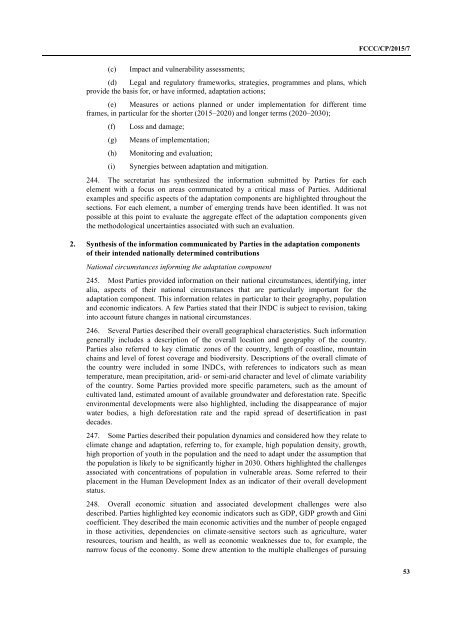FCCC/CP/2015/7
1PYuHQM
1PYuHQM
Create successful ePaper yourself
Turn your PDF publications into a flip-book with our unique Google optimized e-Paper software.
<strong>FCCC</strong>/<strong>CP</strong>/<strong>2015</strong>/7<br />
(c)<br />
Impact and vulnerability assessments;<br />
(d) Legal and regulatory frameworks, strategies, programmes and plans, which<br />
provide the basis for, or have informed, adaptation actions;<br />
(e) Measures or actions planned or under implementation for different time<br />
frames, in particular for the shorter (<strong>2015</strong>–2020) and longer terms (2020–2030);<br />
(f)<br />
(g)<br />
(h)<br />
(i)<br />
Loss and damage;<br />
Means of implementation;<br />
Monitoring and evaluation;<br />
Synergies between adaptation and mitigation.<br />
244. The secretariat has synthesized the information submitted by Parties for each<br />
element with a focus on areas communicated by a critical mass of Parties. Additional<br />
examples and specific aspects of the adaptation components are highlighted throughout the<br />
sections. For each element, a number of emerging trends have been identified. It was not<br />
possible at this point to evaluate the aggregate effect of the adaptation components given<br />
the methodological uncertainties associated with such an evaluation.<br />
2. Synthesis of the information communicated by Parties in the adaptation components<br />
of their intended nationally determined contributions<br />
National circumstances informing the adaptation component<br />
245. Most Parties provided information on their national circumstances, identifying, inter<br />
alia, aspects of their national circumstances that are particularly important for the<br />
adaptation component. This information relates in particular to their geography, population<br />
and economic indicators. A few Parties stated that their INDC is subject to revision, taking<br />
into account future changes in national circumstances.<br />
246. Several Parties described their overall geographical characteristics. Such information<br />
generally includes a description of the overall location and geography of the country.<br />
Parties also referred to key climatic zones of the country, length of coastline, mountain<br />
chains and level of forest coverage and biodiversity. Descriptions of the overall climate of<br />
the country were included in some INDCs, with references to indicators such as mean<br />
temperature, mean precipitation, arid- or semi-arid character and level of climate variability<br />
of the country. Some Parties provided more specific parameters, such as the amount of<br />
cultivated land, estimated amount of available groundwater and deforestation rate. Specific<br />
environmental developments were also highlighted, including the disappearance of major<br />
water bodies, a high deforestation rate and the rapid spread of desertification in past<br />
decades.<br />
247. Some Parties described their population dynamics and considered how they relate to<br />
climate change and adaptation, referring to, for example, high population density, growth,<br />
high proportion of youth in the population and the need to adapt under the assumption that<br />
the population is likely to be significantly higher in 2030. Others highlighted the challenges<br />
associated with concentrations of population in vulnerable areas. Some referred to their<br />
placement in the Human Development Index as an indicator of their overall development<br />
status.<br />
248. Overall economic situation and associated development challenges were also<br />
described. Parties highlighted key economic indicators such as GDP, GDP growth and Gini<br />
coefficient. They described the main economic activities and the number of people engaged<br />
in those activities, dependencies on climate-sensitive sectors such as agriculture, water<br />
resources, tourism and health, as well as economic weaknesses due to, for example, the<br />
narrow focus of the economy. Some drew attention to the multiple challenges of pursuing<br />
53


